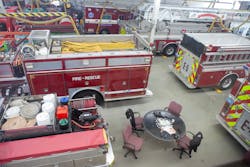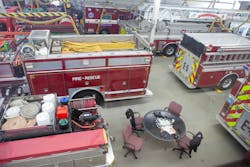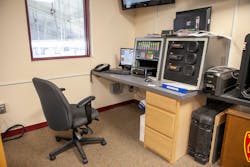Close Calls: Lonely & Dangerous Fire Responses
This month, I am providing you with an opinion. It’s yours to do what you want with. Obviously, I hope these words will matter ... and not just to you. We shall see.
While for almost two decades each month we normally review incidents and provide facts and feedback so what went wrong can be avoided, this month, as everyone gathers in Nashville, TN, for Firehouse Expo, I want to raise a very critical issue. One that many will be talking about in Nashville, while others have their heads in the sand.
The volunteer fire/EMS/rescue service in North America is in a major and measurable crisis. To be clear, it is not “gonna be in a crisis” ... it IS in a crisis and few want to genuinely fix the problem. Now, when I say “fix the problem” I mean fix it so when someone dials 9-1-1, they hear fire apparatus sirens a few minutes later.
It is very predictable that a fire grows at a certain pace, and if the fire department cannot get ahead of that with rapid turnout, response and operations, then we have the recipe for a major close call, or something much worse.
It is very simple. We need the right amount of qualified and able firefighters toned out and turning out quickly to fix the peoples’ problems. How’s that for a mission statement?
You may have seen recent national headlines where a volunteer fire department response time didn’t meet the needs of the people having the fire. People are up in arms, calling for a paid fire department ... an understandable and emotional knee-jerk reaction to the problem that’s been around for a while. Everyone saw it coming, but no one did anything about it. Actually, everyone at the fire department saw it coming ... the public assumed that when they dialed 9-1-1 fire trucks would arrive. Fooled ya!
The problem I am talking about is with an unstaffed fire department or company—one in which members come from home or work—when the tones go off, and they go off again, and they keep going off until maybe someone responds, regardless of their qualification or abilities. Maybe.
Suburban vs. rural fire response
I want to clarify that I am going to narrow my focus on this problem on the suburban, populated areas. However, to be clear, if someone lives (for example) in a rural area, they will get a rural response which means a long and very limited response in most cases. You cannot, on one hand, want to live among nature, miles from the nearest human being, but then have an emergency and expect service a few minutes later. Other than rare occasions, your stuff is gonna burn up (without residential sprinklers) and whoever had the heart attack is in real, real trouble. That’s just how it generally works with rural living, which makes it time for everyone to join a volunteer fire department.
Additionally, I travel frequently and always have my scanner on, and in so many cases, like described, I hear tones ... and then tones ... and then tones ... and the response is a crapshoot. I recently spoke with a fire chief friend who told me that one of his stations fails to turnout 50 percent of the time. Fifty percent of the time, no one shows up in a densely populated suburban/urban area.
A few years ago I heard a call for someone having trouble breathing, and tones went out, and then three minutes later the dispatcher advised that the person was having severe trouble breathing, and the tones went out, and then about 10 minutes into the run they advised the person was unconscious, and more tones went out, and then it was a non-breather/cardiac arrest, and tones didn’t matter any longer.
Are we fooling the public?
I can also give similar examples for fires, with this being one of my favorite (sad/reality) stories. A building fire was transmitted, and the fire company had not turned out. So, tones went off again. Eventually, about 10 minutes into the fire, an engine finally responded with a driver and four firefighters. What happened at the fire is irrelevant. The issue here is that the driver was 70 years old and the crew were high school firefighters age 17, who left school for the run. Any problem with that? ABSOLUTELY ... that is not a fire department response on anyone’s calculations.
I don’t care if they were all able to blow the fire out, at 17 years old they are not qualified to do anything but support qualified, trained and experienced firefighters on a scene, and definitely not be the firefighters.
The scenario consisted of a veteran firefighter, who at age 70 SHOULD NOT have to be relied upon to get a rig out, and a bunch of well-meaning but unqualified kids.
I am not picking on 70-year-old firefighters—I am six years away from being one myself, hopefully—but what I am saying is that, at that age, helping out is fine; being a primary responding firefighter is not fine. Not at age 70.
When we have a firehouse and we have trucks in that firehouse, the public should safely assume that when they call us for help, qualified help—and plenty of it—will come quickly. But that’s not the case, as so many departments are fooling the public.
While there are certainly some well-staffed volunteer fire/EMS departments—primarily those who know they have a crew either by mandated schedules, mandated in-house duty crews or phone apps—many more cannot assure a response.
It’s about the greater them, not the greater us!
To be clear, those in charge (such as elected officials, local government officials, fire commissioners, boards of directors or whomever) have a clear, and perhaps legal, obligation to fix the problem locally or regionally. It needs to be fixed for the people who make the donations, pay the taxes and have the emergencies. That’s pretty much it.
Some volunteer fire/rescue/EMS folks don’t like the word “mandate” ... well, I don’t like the word “fat-free” but I see it and face it each day if I want to continue enjoying life. Sometimes things are mandated for the good of those needing help. The greater good; not the “greater you.”
Volunteer—a person who voluntarily undertakes or expresses a willingness to undertake a service. Nowhere in that meaning will you find anything that talks about “when you feel like it” or “on your own terms” or “when it’s not raining.” Volunteer means that the SERVICE has been defined and you VOLUNTARILY decided to assist in providing that service based upon what the community needs, not what you need.
In the previous scenario about the 70-year-old firefighter, a friend of mine (who lives in the biggest city in America) stated, “That’s ridiculous! They need to have a paid fire department!” I explained to her that it wasn’t that simple. Or is it?
What is happening to volunteer fire departments?
The volunteer service in North America has been declining for years for a variety of reasons. I believe these are some of the main reasons the volunteer service suffers:
An organization’s unwillingness to change to meet the current community demands.
The way members are treated by the organization (policies, procedures, fairness, equality)
Time/availability and related membership requirements, of which some are valid, and some are ridiculous and should no longer be required.
For example: Fundraising. In 2019, where so many volunteer fire departments can barely survive just training and responding, it is time for the burden of “fundraising” for the purpose of buying fire equipment to be replaced by a tax.
You don’t see cops “fundraising” to buy police cars, or the mayor or city manager “fundraising” to buy their desk or sanitation workers “fundraising” to buy garbage trucks. Wake up! People don’t join volunteer fire/EMS agencies to raise money so they can train and run calls for free.
I also believe a significant societal change has occurred, one that most cannot control. Quite simply, people feel they are very busy these days. Or at least it seems that way and that’s what people think. Google “Why are we so busy” and you’ll find some great articles on that subject, and you can reach your own conclusions.
What the response should look like
The bottom line is that volunteers join in order to help people having a bad day. So then, do that! But, do it on the terms of those who need help, not your own terms. Not doing that, but retaining unearned benefits, is selfish. Doing it on your own terms provides the community with a false sense that, “Those fire trucks will come roaring out of those bay doors if we need help 24/7/365!” But, that’s hardly the case.
Let’s take a look at standards (angry crowd yells, “WE HATE STANDARDS!”). And let’s look at them as if your family (spouse, partner, loved ones, kids, grandkids, etc.) are the ones needing 9-1-1 emergency help ... and they need it right now.
According to the NFPA standards for volunteer department response:
- Urban Demand Zones (more than 1,000 people per square mile)—the minimum response staffing is 15 personnel, arriving at the scene within nine minutes, for 90 percent of such calls.
- Suburban Demand Zones (500–1,000 people per square mile)—the minimum response staffing is 10 personnel, arriving at the scene within 10 minutes, for 80 percent of such calls.
- Rural Demand Zones (less than 500 people per square mile)—the minimum response staffing is six personnel, arriving within 14 minutes, for 80 percent of such calls.
So, if your department falls into the Urban Demand Zone ... and that means 90 percent of the time (day, night, etc.) you are expected to have 15 fully qualified fire folks (interior certified firefighters) on the scene in nine minutes.
The question is simple: Can you do it or not?
You know the answer, it’s in your company or department’s stats for the past five years. Now I know we hate standards, so let’s remove the standard and ask the question: If your house was on fire or your kids needed emergency help, is nine minutes acceptable to you? Well hot damn ... it is that simple.
The title of this column is “Lonely & Dangerous Fire Responses.” The “Lonely” is for those crews that respond understaffed. The “Dangerous” is for those who await the fire department that takes way too long to turnout and arrive ... and predictably dangerous for all.
Research shows that 30 years ago, people had about 17 minutes to get out of a house fire. Today, it’s down to three or four minutes because newer homes and the furniture inside burn a lot faster. Think about that, just three to four minutes.
What can, or should, we do?
So, can your volunteer department, company or district do the above for those people you love? Your stats and your hearts know the answer. Is it time to change? Your hearts and stats know that answer as well.
When a department can no longer meet best practices and standards (community needs), standards that were created because people burned up in fires, lost their homes, died in savable EMS scenarios, etc., it is time to make it clear to the community what your department’s capabilities are (what your department can realistically do and not do) and give the community a choice in determining their level of service.
Changing (aka evolving) does NOT have to mean the “death” of a volunteer department, however, it does mean a rebirth to stay focused on the original mission that the founders of that agency had in mind, helping people. Neighbors helping neighbors, that sort of stuff. It may mean adding bunk rooms in and requiring members to pull a shift, assuring rapid response. It may mean enforcing current rules requiring ALL members to maintain a certain level of activity. It may mean paying those members for their time. It may mean hiring people. It may mean consolidation, collaboration or mergers. It may mean numerous small communities fund a single “regional” engine company that’s well staffed, providing a rapid response to several areas. Or, it may mean all of the above along with some automatic mutual aid.
It will mean that your department needs to be honest with the community, present them with an intelligent and factual proposal of change and let them vote on whatever funds might be needed to provide the needed level of service. Maybe they like it the way it is, or maybe they have no clue and expect those trucks to come rolling down the street filled with qualified firefighters. It is up to them to decide, but up to us to be honest.
While it can be a factor, attorneys (or the threat and worry of) should not be your focus—your focus should be on what’s best for those needing help, including your own family. Doing what is expected by a volunteer fire/rescue/EMS department is not always what’s best for the personal agendas of some of your members … and it never should have been.
Volunteer fire departments were formed to help fix a problem that existed at the time of formation. Unfortunately, while many communities have changed substantially, the fire protection “plan” or “system” remained the same as it did 50 years ago, back when they would blow the fire whistle and await the homeowner, the business owner, the gardener, the attorney, the barber and many others to drop what they are doing and run to the firehouse.
But it’s 2019, and they aren’t coming. So, now what’s your plan? Better we ask and discuss it here as opposed to discussing “that fire” in the near future. The fire that went horribly wrong because of delayed response times and poor turnout. That predictable “close call” fire.
About the Author
Billy Goldfeder
BILLY GOLDFEDER, EFO, who is a Firehouse contributing editor, has been a firefighter since 1973 and a chief officer since 1982. He is deputy fire chief of the Loveland-Symmes Fire Department in Ohio, which is an ISO Class 1, CPSE and CAAS-accredited department. Goldfeder has served on numerous NFPA and International Association of Fire Chiefs (IAFC) committees. He is on the board of directors of the IAFC Safety, Health and Survival Section and the National Fallen Firefighters Foundation.



